After winning Kyrie Irving‘s debut on February 8, 2023, the Mavericks had a 30-26 record and held the fourth seed in the Western Conference. Over the next two months, however, Dallas lost 18 of 26 contests to wrap up the 2022/23 season, free-falling down the standings to 11th place and missing out on not just the playoffs but the play-in tournament too.
It was an inauspicious start for the star backcourt duo of Irving and Luka Doncic, who struggled to share the ball effectively in crunch-time situations (10 of those 18 losses down the stretch came by five points or less). Crucially though, on the heels of a turbulent stay in Brooklyn, Irving earned rave reviews for his locker room presence and leadership during his first few months in Dallas, inspiring confidence that with more time to practice and play together, he and Doncic would figure things out on the court.
 Buoyed by better chemistry between Doncic and Irving and the addition of rookie center Dereck Lively, whom the Mavericks were able to draft due to their late-season slide in ’22/23 (their first-round pick was top-10 protected), the team once again had a solid first half in ’23/24 and entered trade-deadline day with a 28-23 record. And once again, Dallas had an eventful deadline, acquiring P.J. Washington and Daniel Gafford in separate deals by sending out two of just three future first-round picks that changed hands league-wide on February 8.
Buoyed by better chemistry between Doncic and Irving and the addition of rookie center Dereck Lively, whom the Mavericks were able to draft due to their late-season slide in ’22/23 (their first-round pick was top-10 protected), the team once again had a solid first half in ’23/24 and entered trade-deadline day with a 28-23 record. And once again, Dallas had an eventful deadline, acquiring P.J. Washington and Daniel Gafford in separate deals by sending out two of just three future first-round picks that changed hands league-wide on February 8.
Washington and Gafford certainly didn’t bring the kind of star power to the franchise that Irving had a year earlier, but the two role players also didn’t require the adjustment period that Kyrie had in 2023 — they were perfect fits in Dallas from day one. Instead of slumping down the stretch, the Mavs took off, going on a 22-9 run from deadline day through the regular season finale and moving up in the standings from No. 8 to No. 5.
While the Mavericks didn’t enter the playoffs as favorites to come out of the West, they quickly made it clear that their second-half surge was no fluke, dispatching the No. 4 Clippers in round one, knocking off the top-seeded Thunder in round two, and then making quick work of the favored Timberwolves in the Western Conference finals, winning three games in Minnesota en route to a 4-1 series victory.
The Mavericks’ run ended in the NBA Finals against a dominant Celtics team that won 64 regular season games and went 16-3 in the postseason, but Dallas was playing with house money by that point. If you’d told anyone in the organization before the season began that the Mavs would follow up their 38-win dud of a 2022/23 season with an appearance in the NBA Finals a year later, they would’ve taken that outcome in a heartbeat.
The expectations will be higher in Dallas going forward, and after falling short of a championship this spring, the Mavs will have to figure out how to get back to the NBA Finals — and how to put themselves in a better position to win it all once they get there.
Head of basketball operations Nico Harrison has done a good job so far adding complementary pieces around his franchise player (Doncic) and raising the ceiling of this roster, but there are still areas that could use an upgrade. With no cap room this offseason and their collection of future draft picks somewhat depleted, the Mavs may need to get creative to keep getting better.
The Mavericks’ Offseason Plan
In his end-of-season press conference, Harrison expressed confidence that the Mavs’ core doesn’t require any major changes, telling reporters, “If you look at our top seven or eight players that really played. I don’t see anything happening with that.”
Doncic, Irving, and Lively certainly aren’t going anywhere, and it’s safe to assume Washington and Gafford will be back after helping turn the team into a legitimate contender after the trade deadline. After that though, I’m not sure I’d write any names in pen for next year’s roster.
Beyond those five players, Josh Green and Maxi Kleber are the best bets to be back. Green, who signed a three-year rookie scale extension prior to the start of the season, battled some health issues but once again had a solid year, knocking down 38.5% of his three-pointers, handing out a career-high 2.3 assists per game, and providing solid, versatile defense on the wing. Kleber also had an injury-plagued season, appearing in just 43 contests, but continued to be a very useful frontcourt role player when available — he’s not as athletic as Lively or Gafford and won’t show up on many highlight reels, but the German big man is a versatile defender who can hit a three-pointer.
We’ve mentioned seven of Dallas’ eight highest-paid players so far. The one in that group who is least likely to return is Tim Hardaway Jr. The veteran wing, who came over from New York in the Kristaps Porzingis trade in January 2019, is one of the longest-tenured Mavericks, but his 26.8 minutes per game in 2023/24 represented his lowest average since he arrived in Dallas and his .353 3PT% was below his career rate. Hardaway battled an ankle injury in the playoffs and wasn’t used much even when he was healthy, logging just 12.7 MPG in 14 postseason appearances.
Between Hardaway’s declining role and his expiring contract (worth approximately $16.2MM), he’s the team’s most obvious trade candidate entering the summer. Any major deal – whether it’s to acquire another impact player or to create extra cap flexibility – seems almost certain to include the 32-year-old.
The Mavs aren’t loaded with tradable draft assets after having given up their 2027 first-round pick for Washington and their 2029 first-rounder for Irving. But they still have the ability to move both their 2025 and 2031 first-round picks if they make them unprotected (neither one is eligible to be pushed back a year due to the Stepien rule and the seven-year rule). They could also sweeten a potential trade offer by including one or both of Olivier-Maxence Prosper and Jaden Hardy, two youngsters who will be 22 in July and who have flashed upside early in their NBA careers.
It’s certainly possible that Dallas will make an effort to acquire another high-caliber starter together using a package that includes Hardaway, one or both of their remaining first-round picks, and one of both of those prospects. But I also wouldn’t be surprised if the Mavs look to make a smaller, cost-cutting move that turns Hardaway into a less expensive rotation piece.
For instance, a deal with the Hornets for wing Cody Martin ($8.1MM) would be legal whether or not Charlotte operates under the cap — perhaps Dallas could entice the Hornets to take on that extra salary by attaching a second-round pick or two to Hardaway. That’s just one example. There could be other teams willing to make a similar move, especially since Hardaway is still capable of providing decent rotation minutes.
The thinking here is that the Mavericks probably won’t be in position to re-sign Derrick Jones unless they trim their payroll a little. They project to operate over the tax line and possibly right around the first tax apron, which means that their only options for re-signing Jones are to offer him a Non-Bird raise (20% above his minimum salary) or to give him the full taxpayer mid-level exception ($5.18MM). Rival suitors, who would likely be eager to poach the Western champions’ starting small forward and top perimeter defender, would easily be able to top either offer.
However, if Dallas can create a little extra breathing room below the first apron, they’d be able to use more than the taxpayer portion of the mid-level exception – potentially as much as the full non-taxpayer mid-level of $12.86MM – to make a more competitive bid for Jones.
Spending more than $5.18MM of the MLE would hard-cap team salary for 2024/25 at the first apron (around $178.7MM), and Dallas already projects to have about $173.7MM counting toward the apron for 12 players, assuming Dante Exum‘s $3.15MM non-guaranteed salary is retained. So swapping out Hardaway for a player making half as much money would put the Mavs in a far better position to re-sign Jones. Veteran Dallas-area reporter Marc Stein has suggested that moving Hardaway is a “key element” of the club’s plan to keep Jones.
While sending out Hardaway in what’s essentially a salary dump would take a key salary-matching piece off the table for the Mavs’ next big trade, the team still has several mid-sized contracts on its books that could be used in such a deal. Kleber, Green, Gafford, and Washington are all earning in the $11-16MM range and are under contract for multiple seasons. Jones could join that group if Dallas is able to free up the non-taxpayer MLE to give him a new contract.
When asked after the Mavs’ season how the team will get better going forward, Harrison spoke about wanting each of his players to improve by “10 to 15 percent.” That suggests to me that he’s willing to be patient and to see how the current group does with a full training camp together rather than going out and immediately taking another big swing this summer. There will be non-Hardaway contracts to use in a bigger trade down the road if the front office eventually determines that’s what’s needed to get Dallas over the hump.
Further down on the offseason to-do list, there are five Mavericks who will be extension-eligible before the season begins, but Hardaway isn’t a candidate for a new deal from Dallas and there should be no rush to extend either Gafford or Kleber, who each have two guaranteed years left on their current contracts.
Hardy is a potential extension candidate, but again, there’s probably not a lot of urgency to get something done right away unless he’s willing to give the Mavs a team-friendly rate — he’ll be extension-eligible all season long, and if he doesn’t get a new deal, the club will have plenty of leverage next summer when he’ll be eligible for restricted free agency.
That leaves Doncic, who is a lock to get a huge new maximum-salary extension from the Mavericks. However, it won’t happen this summer. The superstar guard met the performance criteria for a super-max extension (which will start at 35% of the cap instead of 30%) this spring by making his second consecutive All-NBA team, but he only has six years of NBA service. A player must have seven to sign a super-max extension, so while Doncic is technically eligible to sign an extension this offseason, he won’t be eligible to sign that more lucrative super-max contract until July 2025.
The Mavs would obviously like to get Doncic locked up long-term as soon as possible, but they can at least feel pretty confident that the 25-year-old will be ready and willing to sign on the dotted line in 2025. Following a sub-.500 season in 2022/23, another disappointing result in ’23/24 might have prompted Doncic to question his ability to win in Dallas. This year’s success should assuage any doubts he may have had.
Salary Cap Situation
Guaranteed Salary
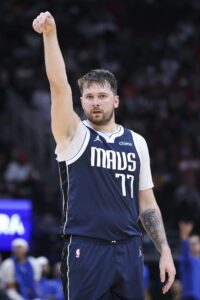 Luka Doncic ($43,031,940)
Luka Doncic ($43,031,940)- Kyrie Irving ($41,000,000)
- Irving’s cap hit includes a $40,000,000 base salary and $1,000,000 in likely incentives.
- Tim Hardaway Jr. ($16,193,183)
- P.J. Washington ($15,500,000)
- Daniel Gafford ($13,394,160)
- Josh Green ($12,654,321)
- Maxi Kleber ($11,000,000)
- Dereck Lively ($5,014,560)
- Dwight Powell ($4,000,000)
- Olivier-Maxence Prosper ($2,870,400)
- Jaden Hardy ($400,000)
- Partial guarantee. Rest of salary noted below.
- Total: $165,058,564
Non-Guaranteed Salary
- Dante Exum ($3,150,000)
- Exum’s salary will become guaranteed if he remains under contract through June 29.
- A.J. Lawson ($2,120,693)
- Jaden Hardy ($1,619,699)
- Partial guarantee. Rest of salary noted above; Hardy’s salary will become guaranteed if he remains under contract through June 30.
- Alex Fudge (two-way)
- Total: $6,890,392
Dead/Retained Salary
Player Options
Team Options
Restricted Free Agents
Two-Way Free Agents
Draft Picks
- No. 58 overall pick (no cap hold)
Extension-Eligible Players
- Luka Doncic (veteran)
- Daniel Gafford (veteran)
- Extension-eligible as of October 1.
- Tim Hardaway Jr. (veteran)
- Jaden Hardy (veteran)
- Maxi Kleber (veteran)
- Extension-eligible as of September 8.
Note: Unless otherwise indicated, these players are eligible for extensions beginning in July.
Unrestricted Free Agents
Other Cap Holds
- Nicolo Melli ($5,066,667 cap hold)
- Theo Pinson ($2,093,637 cap hold)
- McKinley Wright IV ($1,867,722 cap hold)
- Moses Wright ($1,867,722 cap hold)
- Total (cap holds): $10,689,911
Note: The cap holds for these players are on the Mavericks’ books from prior seasons because they haven’t been renounced. They can’t be used in a sign-and-trade deal.
Cap Exceptions Available
Note: The Mavericks project to operate over the cap and either at or above the first tax apron. If they move below the first apron, they would gain access to the bi-annual exception ($4,681,000) and the full mid-level exception ($12,859,000) instead of the taxpayer mid-level exception and would regain access to their two trade exceptions (the largest of which is worth $4,953,980 and expires on July 8). If they surpass the second tax apron, they would lose access to the taxpayer MLE.
- Taxpayer mid-level exception: $5,183,000

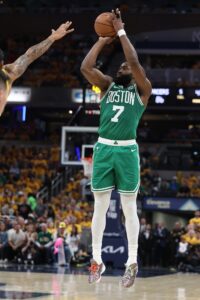 The first chart shows the maximum salaries for a player re-signing with his own team — a player’s previous team can offer five years instead of four, and 8% annual raises instead of 5% raises. The second chart shows the maximum salaries for a player signing with a new team.
The first chart shows the maximum salaries for a player re-signing with his own team — a player’s previous team can offer five years instead of four, and 8% annual raises instead of 5% raises. The second chart shows the maximum salaries for a player signing with a new team.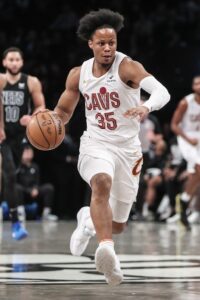
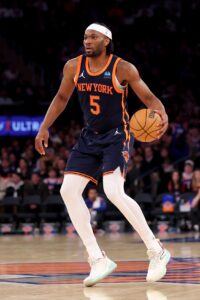
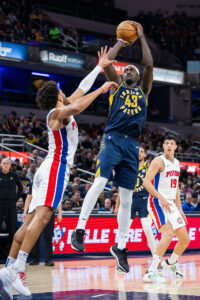 In January, the Pacers
In January, the Pacers 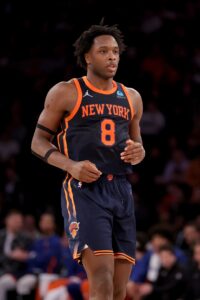 From the Knicks’ perspective, the trade broke down as follows:
From the Knicks’ perspective, the trade broke down as follows: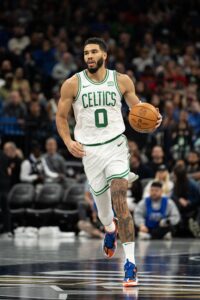 After adding
After adding  Buoyed by better chemistry between Doncic and Irving and the addition of rookie center
Buoyed by better chemistry between Doncic and Irving and the addition of rookie center 